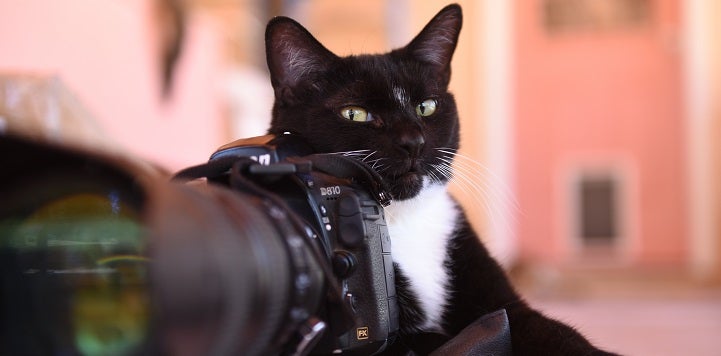
Digital Fundraising Playbook Series: Choosing Images for Digital Fundraising
Introduction
There are three general criteria for choosing photos that produce the most successful fundraising results. However, your fundraising images should be consistent with your overall visual identity (part of your brand). As always, that identity and brand are determined by your choices about who you want the organization to be and how you want supporters to perceive and respond to your lifesaving work.
1. Photos should be vivid and happy.
You are competing for attention with millions of other photos on the web. Many of these photos are the best and brightest from personal collections. Photos that are low contrast, or dark in color or subject matter, are simply at a competitive disadvantage.
Sadly, many people are reluctant to adopt pets with medical or behavioral issues (even those that can be treated), and dark photos of unhappy animals in cramped or dirty environments do nothing to address these concerns. Photograph the animals outside, if possible, in sunshine and green grass, or in offices with good lighting and some homey, cozy elements such as rugs, drapes, furniture or windows.
Best Friends has always chosen not to use negative images of animals. There is a solid rationale behind this: All of us who care about animals feel responsible for the welfare of animals who can’t protect themselves. When negative images are used to provoke guilt or fear as a way of motivating people to take action, that sense of responsibility can become overwhelming. Instead of empathizing with the animals and taking action to help them, people tend to shut down emotionally.
This is what we have learned about images over the years:
- Negativity suppresses response. The use of negative images depresses supporters and suppresses their responses.
- Negativity is short-lived. Even when negative images work, they only work in the short term. Studies show that after repeated viewings of negative images (and video), people become numb. At best, people may respond once just to make the bad feelings go away, but they will not continue the response.
- Negativity leads to avoidance. Repeated exposure to negative images and stories leads to declining response, increased annoyance and, eventually, avoidance of your photos and messages altogether.
- Negativity damages your brand. There is strong evidence that long-term exposure to negative messages damages the entire organization’s reputation, because people subconsciously associate the organization with the negative images they’ve seen before.
Best Friends believes that showing people the potential happy ending is the solution. Instead of using images of animals in peril, use images of healthy, happy pets around people. That’s what all your supporters want in the end, so help them see what’s possible if they work together with you.
2. Photos should generally include a human.
Unless you’re taking shots of pets to accompany their adoption profiles, your photos should include humans. People want happily-ever-after and a happy animal in the context of happy people is the future they want to create. This strategy allows people to project themselves into the image (and the scenario it represents), and also helps people see that the animals are happy, loved and safe to be around.
For your website, choose pictures of happy pets interacting with humans rather than photos of the outside of your building or other inanimate objects that don’t reflect the impact of your lifesaving work. You don’t always have to include a human face. Even the suggestion of a human (a loving hand, kitten in lap, etc.) can work.
3. Photos should be easily recognizable, even at small sizes.
You have just a few seconds to grab viewers’ attention and persuade them to empathize with your organization and your community’s homeless pets. If potential supporters have to spend time figuring out what the subject of an image is, that’s time they’re not spending reading and engaging with the rest of the content.
Conclusion
Animal welfare is loaded with opportunities to tell a compelling story through powerful and appealing images. Both story and image are part of your organization’s overall identity and the brand you build and encourage donors and other supporters to rely on.
While some organizations choose to focus on images that display the challenges or heartbreak of animal welfare, Best Friends has had a great deal of success with a positive approach, using appealing photos and hopeful stories.
Whatever choices you make, always ask yourself what story you are trying to tell with an image, and if the answer to that question is not immediately clear, re-think your concept. You won’t need a thousand words if your picture grabs the attention of potential donors and inspires them to take action.
Resources
- HeARTs Speak is a nationally recognized nonprofit that’s uniting art and advocacy to increase the visibility of animals in shelters.
- Petfinder offers tips on how to photograph adoptable pets.
- By googling how to photograph adoptable pets, you can find an entire list of resources.
- GlobalGiving offers practical photography tips for fundraising.
- Even a behind-the-scenes look at creating your animal images can charm your donors. This video features a day out with Best Friends photographers and some of their most lovable subjects.
In our digital playbooks, Best Friends is not endorsing any specific product, platform, or company. We share our knowledge of (and experience with) digital tools, and we strongly encourage every organization to research, test, and choose tools based on the organization’s specific needs.
All images were selected from the Best Friends visual style guide 2021.
If you found this playbook helpful, check out our full catalog of handbooks, manuals, and playbooks.